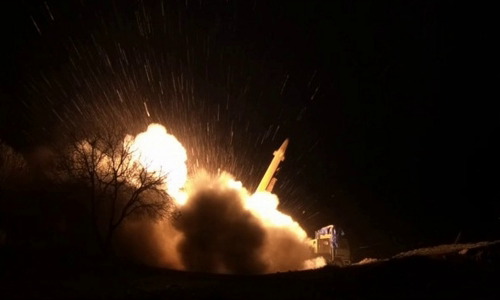The Iranian ballistic missile displayed accuracy in a raid on its base in Iraq on January 8, forcing the United States to strengthen its shield in the Middle East.
"Iran is a potential opponent, it possesses the ability to attack and threaten American lives. We are considering adding defense systems to the region, which may include missile shields. "US Army Secretary Ryan McCarthy told reporters on January 15.

Iranian ballistic missiles leave the launch platform dawn 8/1 Photo: IRNA
The remarks came after Iran broke out on January 8 to launch a series of ballistic missiles at two US military bases based in Iraq in response to an air strike that killed General Qassem Soleimani. Experts say this attack and the Saudi Arabian oil plant's raid in September 2019 showed Iran possessing an advanced missile arsenal with great range, precision and accuracy. ability to deter opponents in the area.
Satellite images of Planet Labs show that Iranian ballistic missiles have dropped four positions at the Ain al-Asad air base on the outskirts of Baghdad. Some of the US CV-22 helicopters in the brothels could be damaged or destroyed, and taxiways in the southeast region of the base, where the hangars and runways between the airport were hit by missiles.
Despite heavy attacks, Iranian ballistic missiles did not fall into the shelter of American soldiers and coalition fighters against the Islamic State (IS) claiming to be on both bases. The US and Iraqi forces both claimed no deaths after the attack, only 11 US soldiers suffered a concussion. The result of the attack is nearly identical to the attack on the Saudi oil plant, when half of Riyadh's crude production was cut off without death.
"It is not a normal ballistic missile. They use high-precision guided weapons. Iran does not want Americans to shed blood," said Tom Karako, director of the Rocket Defense Project at the Strategic Center and International Research (CSIS) based in the US, commented.
The Islamic Revolutionary Guards are most likely using the Qiam-1 and Fateh-110 missiles for this attack. These are two main models of Iran's short-range ballistic missiles, constantly upgraded and equipped with the most modern equipment of this country.
They are fitted with inertial and satellite navigation systems, and optical-electronic probes for increased accuracy. Each bullet can hit a target within a radius of 3-10 m from a distance of 300 km with Fateh-100 or 800 km with Qiam-1.
The Pentagon rejected the assertion that Iran deliberately avoided positions with US and Iraqi soldiers, while heightening the role of border systems and asserting that US troops had enough time to shelter.
However, it cannot be ignored that Iran chooses ballistic missiles to conduct the raid, instead of using long-range cruise missiles and drones (UAVs) such as the attack on the Saudi oil plant. last year. The two ballistic missiles both have relatively high firing trajectories, are easily detected by radar and satellites, allowing the United States to issue early warnings.
Iran focuses on developing offensive missiles to fill the air gap with the United States and its allies. "It is an irreplaceable component of Tehran's defense strategy, helping to fill the void of strategic fighters and bombers," expert Robert Einhorn wrote in a report published by the Brookings Institution last year.
Missile systems can cover the entire Middle East of Iran. Click on the image to see it in full.
Tehran has ballistic missiles with a range of over 2,000 km, and Soumar cruise missiles that can hit targets from a distance of 2,500 km. This poses a series of challenges for Iran's rivals. It has repeatedly launched ballistic missiles against ISIS rebels in Syria in 2017 and 2018, seemingly to warn potential Tehran enemies.
"The most important message sent to the US is that Iranian missiles are capable of penetrating US air defenses. These are warning shots," said Professor Mohammad Marandi at Tehran University.



 SerrinaRandolph
SerrinaRandolph







